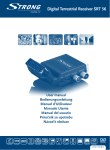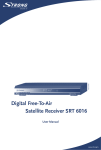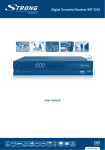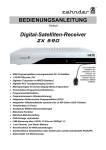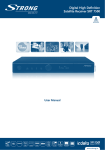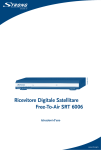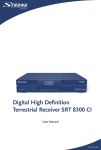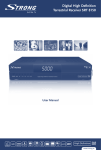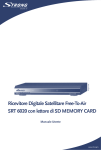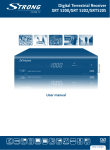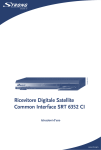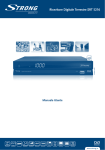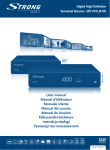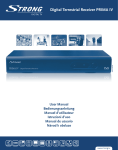Download Digital Satellite Receiver SRT 6511
Transcript
Picture similar Digital Satellite Receiver SRT 6511 User Manual PART 1 • English 1.0 INTRODUCTION 1.1 Safety Instructions 1.2 Storage 1.3 Equipment Set-up 1.4 Features & Accessories 2 2 3 3 3 2.0 YOUR RECEIVER 2.1 Front Panel 2.2 Rear Panel 2.3 Remote Control Unit (RCU) 4 4 4 4 3.0 Connections 3.1 Connecting to TV & VCR 3.2 Connecting to Digital Audio Amplifier 3.3 Connecting to Satellite Dish 3.4 Connecting to computer by serial cable 5 5 5 5 5 4.0 Starting up for the first time 4.1 Language Selection 4.2 Audio Language Selection 4.3 Time Zone adjustment 4.4 Satellite configuration 5 6 6 6 6 5.0 Main Menu 5.1 Installation 5.2 Program Setting 5.3 User preference 5.4 System Setting 5.5 Utility 6 6 8 8 9 9 6.0 OTHER OPERATIONS 6.1 Electronic program guide (EPG) 6.2 Zapping and information banners 6.3 Audio Language selection 6.4 Channel list and view mode 6.5 FAV list 6.6 Teletext function 6.7 Subtitle function 6.8 Sleep Timer function 6.9 Zoom function 10 10 10 10 11 11 11 11 11 11 A.1 TroubleShooting 11 A.2 PIN CODE 12 A.3 Specifications 12 English Table of Contents 1 PART 1 • English 1.0 INTRODUCTION 1.1 Safety Instructions rounding, Polarization — If this product is used with a specified G AC adapter, the adaptermay be equipped with a polarized alternating current line plug (a plug with one blade wider than the other). This safety feature allows the plug to fit into the power outlet only one way. If you cannot insert the plug into the wall outlet, pull it out, reverse it, and then reinsert it. If the plug still fails to fit, contact an electrician and have the receptacle replaced n Protecting the Power Cord — The power supply cord should be placed so it will not bewalked on. Never put a heavy object on the power cord or wrap it around the leg of a table or chair. Keep the area around the power cord connection points, at the power outlet, and at the product connection, free of all AC adapter or accessory power cords n CAUTION: TO REDUCE THE RISK OF ELECTRICAL SHOCK, DO NOT REMOVE COVER (OR BACK). NO USER-SERVICEABLE PARTS INSIDE. REFER TO QUALIFIED SERVICE FOR SERVICING. Explanation of WARNING symbols The lightning flash with arrowhead symbol within an equilateral triangle is intended to alert the user to the presence of not isolated dangerous voltage within the inside of the product that may be of sufficient magnitude to constitute a risk of electric shock to persons. The exclamation point within an equilateral triangle is intended to alert the user to the presence of important operating and servicing instructions in the literature accompanying the appliance. Read the following instructions carefully WARNING: TO REDUCE THE RISK OF FIRE, ELECTRICAL SHOCK OR ANNOYING INTERFRERENCE, DO NOT EXPOSE THIS APPLIANCE TO RAIN OR MOISTURE AND ONLY USE THE RECOMMENDED ACCESSORIES. ead All Instructions — Before you use the product, read all R operating instructions. For more information on accessories such as the lithium ion battery, refer to the manuals provided with those products n Save These Instructions — Save all safety and operating instructions for future reference n Heed Warnings — Read carefully and follow all warning labels on the product and those described in the instructions. n Follow Instructions — Follow all instructions provided with this product n Cleaning — Always unplug this product from the wall outlet before cleaning. Use only a damp cloth for cleaning. Never use any type of liquid or aerosol cleaner, or any type of organic solvent to clean this product n Attachments — For your safety, and to avoid damaging the product, use only accessories recommended by STRONG. n Water and Moisture — Never use this product around water (near a bathtub, kitchen sink, laundry tub, wet basement, swimming pool or in the rain) n Location — To avoid damage to the product and prevent personal injury, never place this product on an unstable stand, tripod, bracket, table or cart. Mount only on a stable tripod, stand, or bracket. Follow the instructions that describe how to safely mount the product,and use only the mounting devices recommended by the manufacturer n Power Sources — Connect this product only to the power source described on the product label. If you are not sure about the type of power supply in your home, consult your local power company n Refer to instruction pages for information on using the product with a battery n 2 GENERAL PRECAUTIONS SAFETY PRECAUTIONS n Lightning — If a lightning storm occurs while using a specified AC adapter, remove it from the wall outlet immediately. To avoid damage from unexpected power surges, always unplug the AC adapter from the power outlet and disconnect it from the receiver when the receiver is not in use n Overloading — Never overload wall outlets, extension cords, power strips, or other power connection points with too many plugs n Foreign Objects, Liquid Spillage — To avoid personal injury caused by fire or electrical shock from contact with internal high voltage points, never insert a metal object into the product. Avoid using the product where there is a danger of spillage n Heat — Never use or store this product near any heat source such as a radiator, heat register,stove, or any type of equipment or appliance that generates heat, including stereo amplifiers n Servicing — Refer all servicing to qualified personnel. Attempting to remove the covers or disassemble the product, could expose you to dangerous high voltage points n Damage Requiring Service — If you notice any of the conditions described below while using a specified AC adapter, unplug it from the wall outlet and refer servicing to qualified service personnel: 1. Liquid has been spilled onto the product or some other object has fallen into the product. 2. The product has been exposed to water. 3. The product does not operate normally despite following operating instructions. Adjust only the controls described in the operating instructions as improper adjustment of other controls could damage the product and require extensive repair work by a qualified technician. 4. The product has been dropped or damaged in any way. 5. The product exhibits a distinct change in performance. n Replacement Parts — When replacement parts are required, make sure that the authorized service center uses only parts with the same characteristics as the originals, as recommended by the manufacturer. Unauthorized substitution of parts could result in fire, electrical shock, or create other hazards n Safety Check — Upon completion of servicing or repairs, ask the service technician toperform safety checks to determine that the product is in good working order n Apparatus shall not be exposed to dripping or splashing and no objects filled with liquids, such as vases, shall be placed on the apparatus. n Where the mains plug or all-pole mains switch is used as the disconnect device, the disconnect device shall remain readily operable. PART 1 • English 1.2 Storage English Your receiver and its accessories are stored and delivered in a packaging designed to protect against electric shocks and moisture. When unpacking it, make sure that all the parts are included and keep the packaging away from children. When transporting the receiver from one place to another or if you are returning it under warranty make sure to repack the receiver in its original packaging with its accessories.Failing to comply with such packaging procedures could void your warranty. 1.3 Equipment Set-up We recommend you to consult a professional installer to set up your equipment. Otherwise, please follow the instructions below: nRefer to the user manual of your TV and your antenna nMake sure that the SCART cable and outdoor components are in a good condition and the SCART connections are well shielded This manual provides complete instructions for installing and using this receiver. The following symbols will serve as follow. Warning Indicates warning information. Tips MENU Move to Indicates any other additional important or helpful information. Represents a button on the remote control or the receiver (Bold Character) Represents a menu item within a window (Italic Character) 1.4 Features & Accessories n For all digital Free-To-Air TV and Radio channels via satellite* n Excellent Audio & Video quality n Quick and easy installation & user-friendly menu n mySAT function: identification and automatic installation of your significant satellites n Memory capacity for 4200 channels, resp. 4000 transponders or 100 satellites n Fast channel zapping: sorting by alphabet, free/encrypted channels or satellite n Advanced Zoom functions for TV pictures n Digital sound through coaxial output (S/PDIF) by connecting to digital amplifier n Parental lock function for menu and selectable per channel n 7 Favourite lists for TV- and Radio channels n Very fast 800 pages teletext** via receiver and teletext via TV remote control n Display showing channel number or time n Electronic TV Programme Guide (EPG) for on screen programme information of present/following event information up to 7 days ** n 8 Timers with 5 modes (once, daily, weekly, working days, weekend) for programming and separate sleep timer n Full multi-lingual DVB subtitling and audio track support** n Multi-lingual support on screen menu (OSD), such as English, German, Czech, Slovakian, Hungarian, Bulgarian, Russian, Turkish n Edit functions for TV or Radio programme name and satellite name n 3 Games (Boxman, Tetris, Snake) and Calendar n Software update via RS-232 port n Signal quality and strength bar for digital transponders n Automatic and manual channel scan options n Power on with last viewed channel n User-friendly remote control with coloured function buttons (infrared up to 7 metres) n Supports DiSEqC 1.0, DiSEqC 1.2 and GOTO X n PAL/NTSC compatible n Power switch * Depending on local signal conditions ** Availability depending on broadcaster Accessories: n User’s Manual n 1 Remote control unit n 2 x Batteries (AAA type) 3 PART 1 • English Note:The batteries should not be recharged, disassembled, electrically short-circuited or be mixed or used with other types of batteries. If rechargeable accumulators instead of batteries are going to be used, we recommend using (e.g. NiMH) types with low self-discharge to ensure long time operation of remote control. 2.0 YOUR RECEIVER 2.1 Front Panel Figure 1 1.Power To put the receiver in and out of standby mode. 2.Menu Used to display the main menu. 3.OK To show TV/Radio channel list and to select a program, highlight a line. 4.CH pq Channel up & down. 5.VOL tu Volume up & down. 6.Lock LED Signal Indicator 7.Power LED Power indicator 8.DisplayShows channel number, boot/loader message and time in standby mode. 2.2 Rear Panel Figure 2 o connect the coaxial cable from your LNB on the satellite dish to this connector. T Gives you the possibility to connect an extra satellite receiver (analogue or digital). This serial port can be used to connect your PC to your receiver to download new software versions to your receiver 4.AUDIO Right and Left Give you the possibility to connect the audio signal to an external amplifier, or the audio input of your TV. 5.VIDEOThis connector has a constant video signal for additional VCR-connections. 6.S/PDIF Use the coaxial output to connect your receiver to the input of your digital audio amplifier. 7.TV SCART To connect your receiver to your TV using a SCART cable. 8.DVD/VCR SCART To connect your receiver to your DVD or Video recorder using a SCART cable. 9.ON/OFF Power Switch 10. Power Cord Your receiver requires a current of 100 ~ 240 V AC (Auto-selectable), 50 / 60 Hz ± 5 %. Make sure to check the power specification before connecting your receiver to the wall outlet. 1.SAT IN 2.SAT OUT 3.RS-232 Serial Port 2.3 Remote Control Unit (RCU) 1. STANDBY/ON: To switch the receiver ON or to Standby. 2. SAT To show the scanned satellite list. 3. MUTE To turn the sound ON/OFF. 4. NUMERIC KEYS (0~9) To insert numbers. 5. RECALL To switch to previously watched channel. 6. TV/RADIO To switch between TV and RADIO. 7. MENU To activate main menu. 8. EPG(Electronic Program Guide) To show the TV/Radio program guide. 9. FAV To get favorite channel list you set before. 10. EXIT To exit current menu or for cancellation. 11. OK To confirm the highlighted menu item. 12. tu: To change volume in viewing mode. 13. pq: To change program. 14. VOL+/- To change volume 15. Page pq Page up/down in menu. 16. AUDIO To select or change the Audio language. 17. PAUSE To freeze the picture. 18. ZOOM Zoom function. 19. i To show the current channel information. 4 Figure 11 PART 1 • English 20. F1 21. F2 22. F3 23. TXT Sleep Timer. Subtitles. No function Teletext English 3.0 Connections 3.1 Connecting to TV & VCR Basic connection with a SCART cable (Fig. 3) 1.Connect the satellite signal from the LNB to the SAT IN connector. 2.Connect the TV SCART connector at the back of the receiver to the SCART IN connector on your TV set. Basic connection with an RCA cable (Fig. 4) 1.Connect the satellite signal from the LNB to the SAT IN connector. 2.Connect the Video RCA connector at the back of the receiver to the Video IN RCA connector on your TV set. Audio IN VIDEO IN 3.Connect the Audio Left and Right RCA connectors at the back of the receiver to the Audio Left and Right IN connectors on your TV set or audio amplifier. Advanced connection of the receiver to the TV set and DVD/Video recorder (Fig. 5) 1.Connect the satellite signal from the LNB to the SAT IN connector. 2.Connect the TV SCART connector at the back of the receiver to the SCART-in connector on your TV set. 3.Connect the VCR SCART connector at the back of the receiver to the SCART-in connector on your VCR. 3.2 Connecting to Digital Audio Amplifier Connect your Digital Audio Amplifier with the S/PDIF connector on the back of the receiver. (Fig. 6) 3.3 Connecting to Satellite Dish Connecting a fixed satellite dish to your receiver (Fig. 7) First choose a satellite you want to receive your signals from, and have your dealer aim your dish at the requested satellite. Connect a coax cable to your LNB and the other end directly to the SAT IN connector of your receiver. Connecting multiple fixed dishes to your receiver using a DiSEqC 1.0 switch (Fig. 8) If you want to watch programs from more than one satellite (For example from ASTRA and from HOT BIRD) it is advisable to use fixed dishes and a DiSEqC 1.0 switch. Have your Dealer aim the dishes at the requested satellites and connect the LNB’s with coax cables to the IN connectors of the DiSEqC 1.0 switch. Connect the OUT connector of the DiSEqC 1.0 switch to the SAT IN connector at the back of your receiver. Connecting a dish on a motorized positioner to your receiver (Fig. 9) Another possibility for watching programs from multiple satellites is by mounting a dish to a motorized DiSEqC 1.2 positioner. Have your dealer mount the dish to the positioner, set the correct angle of the elevation and let him set the center point for your positioner. Connect the LNB with a coax cable to the SAT IN connector of the positioner, and connect the OUT connector of the positioner to the SAT IN connector at the back of your receiver. 3.4 Connecting to computer by serial cable Connect the RS-232 connector on the back of your receiver to the serial port of your computer using a serial (crossed Sub D9) cable. You’ll find instructions how to download software and a loading tool on our website www.strong.tv (support > download). (Fig. 10) 4.0 Starting up for the first time Ensure your satellite receiver is connected correctly to your television and dish, and that your satellite signal is of good quality. (If you are not sure about this then ask your local STRONG dealer to check your installation or satellite signal.) Confirm that the power plug on the receiver is plugged into the wall outlet. Turn on the receiver. It is recommended that you perform the first time installation following the Installation Wizard step by step. It will help you to easily achieve system configuration and channel installation. If you are a professional installer then you can skip wizard by pressing EXIT button and set-up channels using the Installation menu, for details refer to chapter 5.1. 5 PART 1 • English 4.1 Language Selection Press pq buttons to choose your language, press OK to confirm. In case of German selected, there is an extra option available of preset antenna configuration with ASTRA 19.2E (LNB1) and HOT BIRD 13.0E (LNB2) through DiSEqC switch. In Czech the configuration ASTRA 19.2E (LNB1) and ASTRA 23.5E (LNB2) is available. 4.2 Audio Language Selection Select your preferred Audio language using the pq buttons and press OK to confirm. If you have pressed OK by mistake or confirmed a wrong setting you can use the GREEN (Back) button to get one step back at every step of Setup Wizard. 4.3 Time Zone adjustment Select your Time Zone according to the region you live using the pq buttons. For Summertime use the tu buttons to select the correct setting, then press OK to confirm. 4.4 Satellite configuration Select one of the available connection types: Fixed dish, DiSEqC1.2 or GOTO X Settings, using the pq buttons, according to your used dish installation. Depending on the selected Installation you will be guided to different Setup steps. 4.4.1 Fixed dish Now you have the possibility to install your channels from the connected Antenna/s. For manually installation select Search Channel with the pq buttons in case you are connected to single dish and want to setup e.g. ASTRA 19.2E or HOT BIRD 13E. In this case you are guided to Antenna Setting/s and have to setup your Satellite manually, for details refer to chapter 5.1.1 Antenna Setting/s. Select mySAT if you have connected a single dish or multiple fixed dishes and want to install automatically. Select RED (Single Dish) or YELLOW (Multiple Dish). Now the receiver starts process to detect the correct satellite/s. Once finished your receiver shows the found satellite/s & you can execute a channel search on it/ them with RED to Scan ALL channels or GREEN to Scan Free channels. 4.4.2 DiSEqC 1.2 You are now guided directly to menu Antenna Setting/s >Motor setup which gives you the possibility to point the dish to correct position. Use the pq and tu buttons to select and change the settings, for details refer to chapter 5.1.1 Antenna Setting/s under point GOTO X. 4.4.3 GOTO X Settings If you have selected this configuration, then you need to select your country from the list using the pq buttons. If your country is not available you have to choose User define where you can insert the correct position for your longitude angle and direction, latitude angle and direction and the rotating speed. 5.0 Main Menu All the important settings and features of your receiver can be operated in Main Menu. The Main Menu consists of following sub-menus: “Installation”, “Program setting”, “User Preference”, “System Setting” and “Utility”. Press MENU buttons in no-menu state to enter MAIN MENU. 5.1 Installation The installation menu contains following sub-menus: “Antenna Setting/s”, “Edit Satellite data”, “Remove Satellite”, “Satellites search”, “Manual TP Search” and “mySAT Search”. 5.1.1 Antenna setting/s Press OK button to enter Antenna Setting/s menu. Satellite: Here is the first pre-stored satellite shown. Use the u button and pq buttons to select another satellite from the list, press OK to confirm. Transponder:If you change the satellite, the transponder table will be changed automatically. Use the u button and pq buttons to select a transponder from the corresponding satellite, press OK to confirm. LNB frequency: Default configuration is set to Universal, if another LNB is used set the frequency accordingly to the used LNB or define yourself > User define. 22 kHz:This configuration is preset to Auto, because this is the most usual setting for Universal LNB’s, in case your LNB requires another setting you can switch it permanently ON or OFF by using the tu buttons. 6 DiSEqC:If your antenna is connected through a DiSEqC switch and you have already executed the First Installation with mySAT search then this setup is already according your installation. You only need to specify the DiSEqC input in case it has been wrong configured or the installation setup has changed. Use the tu buttons to select the correct setting, press OK to confirm. GOTO X settings: Here you can setup your location in order to use GOTO X type of Positioner. Motor: If you use a motorised dish (DiSEqC 1.2 or DiSEqC 1.3) set DiSEqC1.2 or GOTO X, if not then set to Disable by using the tu buttons. n DiSEqcC1.2 Almost same like GOTO X, but without function of go to position X. For settings please see below description. n GOTO X: Set motor to GOTO X and press OK to enter the menu to adjust the direction of the dish pointing to the selected satellite. Position Auto:Press tu buttons, the dish will be moved to West/East continuously, it will stop until it finds the best signal. Move dish: Press tu buttons, the dish will be moved to West/East to search the best signal, release the button will stop the moving. Fine Tuning: Set the fine tuning, for optimised adjustment. Move step: Move to East or West stepwise. Limit set: Disable or enable West or East limit, for mechanical limit. NOTE: In order to avoid mechanical damage of your dish please, make sure those mechanical limits in your motor are set correctly and dish would not hit any objects on its movement. Store position: Press OK button to save the current position you searched. Go to position: Press OK button to move the dish to the stored position. Go to Reference: Press OK button to move the dish to 0.0 >reference position. Go to X.X: Press OK button to move the dish to exact position of the satellite FTA only: Use the tu buttons to select YES if you want to search only for Free-To-Air channels and NO if you want to search for scrambled channels as well. Start Search: Use the tu buttons to select the scan mode for Transponder, Satellite or Advanced Scan. 5.1.2 Edit Satellite data Dependent on the focus you set with the tu buttons you can edit a satellite or its transponder data. Select a satellite or transponder with the pq buttons and press OK to enter the menu, then PIN-code (default: 0000) is requested. In case you have chosen satellite, the following possibilities are available: Rename, Delete, Move, Add. Rename: Now you can use the tu and pq buttons to choose characters from the shown keyboard, press OK to insert. Press GREEN (Back) button to delete character and use the RED (OK) button to confirm the new name. Delete: This will delete the selected satellite. A message will appear, press OK if you want to delete the satellite or EXIT to cancel. Move: Here you can move the position of the selected satellite in the satellite list. Use the numeric buttons to enter new position. Add: Use the numeric buttons to enter orbital position of the new satellite and tu to select between East or West. In case you have chosen transponder these possibilities are available: Delete, Edit, Add. Delete: This will delete the selected transponder. Edit: Use the numeric buttons to enter the new value for the selected Frequency and Symbol rate and use the tu buttons to select the correct Polarisation and FEC. Add: Like described above, but this will add a new transponder. 5.1.3 Remove Satellite Here you can remove an installed satellite from the list. Use the pq buttons to select the satellite you want to remove, press OK to enter the menu, then PIN-code (default: 0000) is requested. After entering the PIN-code the satellite is marked with X to delete. You can select other satellites to remove or press EXIT. You will be asked for confirmation to delete (OK) or cancel (EXIT). 7 English PART 1 • English PART 1 • English 5.1.4 Satellite Search In Satellite Search menu you’ll find satellite list and transponder list. Select one or more satellite(s) you want to search and press OK to select. Press RED if you want to Scan ALL channels or GREEN to Scan Free channels. 5.1.5 Manual TP Search This menu allows you to search for specific transponders. Use the pq and tu buttons to select the satellite and transponder you want to search for. Furthermore you can use Network search function to find new appeared transponders. With PID search you can enter specific data of a channel. After setup and selection, pressing OK will start the defined scan. NOTE: If Network search function is set to “NO” then receiver will search for the channels that are available from preset transponder table of selected satellite. If it is set to “YES” then receiver additionally search for channels from new transponders via NIT (Network Information Table). Use this option to get newly appeared channels from the satellite. 5.1.6 mySat Search This function will help you to easily and quickly setup satellite installation. Once receiver has finished you will see satellite/s which is/are found and can execute channel search for Scan ALL channels (RED) or to Scan Free channels (GREEN). 5.2 Program Setting 5.2.1 Edit Channels In this menu, you can Rename (YELLOW), Move (GREEN), Delete (RED) and Lock (BLUE) channels. Use the pq buttons to select a channel which you want to edit and then press the corresponding button. Rename: Here you can rename the channel. Use the tu and pq buttons to choose characters from the shown keyboard, press OK to insert. Press GREEN (Back) button to delete character and use the RED (OK) button to confirm the new name. Move:Here you can move the selected channel to desired position, use the numeric buttons to enter. Delete: If you press the RED button, the selected channel/s is marked with X to delete. Once you have pressed EXIT you will be asked if you want to delete, press OK to confirm or EXIT to cancel deletion. Lock:By pressing the BLUE button you can lock or unlock a selected channel, the œ will be shown beside the selected channel. 5.2.2 Edit Favourites In this menu you can choose between 7 FAV groups, using the tu buttons. Press OK button to add the selected channel to the chosen favorite group. You can also rename the FAV group by pressing RED (Rename Favourite) button. Use the tu and pq buttons to choose characters from the shown keyboard, press OK to insert. Press GREEN (Back) button to delete character and use the RED (OK) button to confirm the new name. 5.2.3 Sort Channels You can sort the channel order of the list by Alphabet, FTA -> CAS (Free-To-Air -> scrambled), Satellite, Transponder, Favor -> No Favor. Alphabet: Channels will be sorted in alphabet order. FTA -> CAS: Free-To-Air channels will be placed at the beginning of the list, Scrambled at the end. Satellite: Channels will be sorted in Satellite order. Transponder: Channels will be sorted in the order they were found, beginning with lowest to highest frequency within a satellite. Favor -> No Favor:First favourite channels will be sorted followed by channels which are not Favourites. 5.3 User preference This menu allows you to change several settings concerning OSD (On Screen Display) as: Colour, Transparency, Search Speed, OSD Time Out and Parental Control. Colour: With the tu buttons you can choose between two OSD colours. Transparency:Use the tu buttons to set the transparency as you prefer. 1 stands for highest transparency, 18 for opaque. Search Speed:With the tu buttons you can set the speed for channel search between Normal and Super Fast. OSD Time Out: Use the tu buttons to set the banner timeout. 8 PART 1 • English English Parental Control:Default this small submenu shows Input New PIN-code and Confirm PIN-code, where you can enter new PIN-code and confirm it, if you want to. The default PIN-code is 0000. Use the tu buttons to set Option for Password Lock and Menu Lock. If you want to lock channels, the Password Lock must be switched to ON, or if you want to lock the whole menu, then Menu Lock must be switched to ON, please confirm settings with OK. 5.4 System Setting This menu allows you to change several settings concerning Menu Language, Audio Language, TV Type, TV Screen Mode, Factory Default, Video Output or view the System Info. Menu/Audio Language:Use the tu buttons to set your preferred Menu and Audio language. TV Type:With the tu buttons set the type your TV set is using. If you don’t know which standard your TV has, please select PAL/NTSC. TV Screen Mode: Use the tu buttons to set 4:3 Letter Box/Pan & Scan, 16:9 Wide TV or Auto according the used TV set. Factory default: Please select with the tu buttons which type of factory default you want to execute: All –for all data and settings, Channel List –if you only want to set channel list to default, Only Radio List - if you only want to set radio channel list to default and Only Scrambled Channel - if you only want to set scrambled channel list to default. Video Output: Use the tu buttons to set the type of SCART output signal. System Info: Press OK to show Info about Software version, Loader, Company and Software built date. TIP: Please submit this information to the service in order to get correct and fast after sales service. 5.5 Utility This menu consists of following submenus: Time Setting, Event timer, Calendar and Games. 5.5.1 Time Setting The default time mode is set to Auto. If broadcaster provides GMT, you can set the time zone accordingly, or set your time manually. For the option AUTO you have to set the Time Zone and Summer time using the pq and tubuttons to select and change settings. If you set Time mode to Manual, you need to set Current time and set Current Date using the pq buttons. Use the numeric buttons to type in the current time (in HH/MM) and date (in DD/MM/YYYY) format. To delete current value, use the t button. 5.5.2 Event Timer Here you can set a timer to perform in following modes: Once, Daily, Weekly, MO-FR and SA&SU including timer based power on and power off. Press the YELLOW (Add) button to add a new Timer. With the pq buttons you can select the timer options and with the tu buttons you can change the values of selected options: Channel type: Select between TV and Radio Channel: Select channel from the channel list Date (DD/MM): Use the numeric buttons to type in the start date. Start time (HH/MM): Use the numeric buttons to type in the start time. End time (HH/MM): Use the numeric buttons to type in the end time. Cycle: You can set the cycle of the timer (Once, Daily, Weekly, MO-FR: Monday to Friday, SA&SU: Saturday & Sunday) Once you finished the timer setup, press the OK button to save the settings. You can also edit and/or delete current timer events. Select the event using the pq buttons and press the GREEN (Edit) button, or press the RED (Delete) button. 5.5.3 Calendar The calendar will give you the convenience to check the date. To change the year use the pq buttons, to change the months use the tubuttons. 5.5.4 Games The receiver has three games: Tetris, Snake, Box Man. In this menu you can select the game with the pq buttons and press OK to play the game. 9 PART 1 • English Tetris This is a very classic game, you can play with the pqtu buttons. tu Move block to left or right direction q Drop block p Rotate block BLUE button: Pause Snake tu Move snake icon to left or right direction. pq Move snake icon to up or down direction. If the snake has passed the brown (food) icon length will be increased, if passed through the yellow icon length is decreased. If it has passed through white icon current game is over. BLUE button: Pause Box Man You are the workman and you have to push the balls to their correct positions. The box can only be pushed, never pulled, so you have to be careful not to push them into a corner where you can’t get them out again. You can only push one box at the same time. You can move around by using the tupq buttons. Press RED to Replay this level or GREEN to go to Next level or YELLOW to play Previous level. 6.0 OTHER OPERATIONS 6.1 Electronic program guide (EPG) The EPG shows the current and following program schedule, dependant on the broadcast, it can be shown for up to 7 days. Press the EPG button on the RCU in viewing mode to enter the EPG. With the pq buttons you can select the events from the current program and with the tu buttons you can select the next/previous days. Press the YELLOW button to display the detailed information of the selected event. Press the OK button to display channel list and use the pq buttons to select the channel and then press OK to display EPG of the selected channel. You can program an Event Timer directly from the EPG menu, if you select the event and then press the RED (Timer) button. The parameters for the selected event are already filled out in the appearing Timer menu. If necessary you can change the settings using thetupq buttons. Once all settings as you request press the OK button to add the timer event. Note: Not all broadcasters provide program information. 6.2 Zapping and information banners In viewing mode press the YELLOW i button to show Zapping banner together with technical program details, on screen. On the lower bar you can view the following information about the current program: Satellite name, Program name, program number and time. The following symbols are as well available below the current event headline: For this signs the colour indicates availability -> Blue: not available, Yellow: available. SUB if subtitles are available for the current program, TXT: if Teletext available on the current program, $: if the program is scrambled or Free-To-Air, EPG: if electronic program guide is available and the available/selectable audio channels. In the lower left corner the signal strength and quality are shown. Furthermore you have the possibility to show the Now/Next EPG headline using the RED (Next) button and if you press YELLOW i again you can see the detailed EPG info as well. Use the pq and tu buttons to scroll in the EPG Details. On the Top bar are technical program details shown: frequency, symbol rate, polarisation, Video, - Audio, - PCR and Teletext PID and the number of Audio and Teletext channels. 6.3 Audio Language selection In viewing mode press RED (Audio) button to show the list of audio languages. Use the pq buttons to change the available audio language. Use the tu buttons to change the audio mode: Stereo, Left mono, Right mono. To cancel press RED or EXIT. Note:Audio track with “(AC3)” sign can be listened only if receiver is connected via SPDI/F to digital audio amplifier and it is switched ON. 10 PART 1 • English 6.4 Channel list and view mode In viewing mode press OK button and the channel list will be shown. Press the pq buttons to select the channel and press the OK button to view selected channel. To switch between TV and Radio channels press the TV/Radio button. English You can sort channels by FTA -> CAS by pressing the RED button, or A-Z by pressing the YELLOW button. You can select satellite by pressing the GREEN button. 6.5 FAV list In viewing mode, you can get the Favorite channel list by pressing the FAV button. Press the RED button to change FAV group. If you did not set favorite channels before, it will show All channels list. 6.6 Teletext function In channel view mode press the TEXT button. The OSD Teletext will be shown in case Teletext is available on the current program. With the pq buttons you can scroll displayed page number. You can insert page number directly with the numeric buttons. 6.7 Subtitle function In channel view mode press the F2 button. The list of selectable subtitle languages will appear if DVB subtitle available. With the pq buttons select the subtitle language and press the OK button. In case DVB subtitle aren’t available you can search at Teletext if therefor subtitles are available. Note: The availability of DVB subtitle depends on the broadcaster. 6.8 Sleep Timer function Press the F1 button to activate the sleep timer. Use the tu buttons to switch between following modes: OFF, 15 Min, 30 Min, 45 Min, 60 Min, 90 Min,120 Min and -- Min -> where you can enter your preferred time. 6.9 Zoom function Press GREEN (Zoom) button to get pointer, then use the pq and tu buttons to select position you want to zoom in and press OK to activate the function. A.1 TroubleShooting There may be various reasons for the abnormal operation of the receiver. Check the receiver according to the procedures shown below. If the receiver does not work properly after checking it, please contact the dealer. Do NOT open the receiver cover. It may cause a dangerous situation and the warranty will get void. Problem Possible causes What to do The display on front panel does The power cord is not plugged in. not light up. Check that the power cord is plugged in to the wall outlet. No picture or sound Wrong connection of the Audio/ Video output of the receiver to TV. Audio muting. TV power off. Connect the Audio/Video output of the receiver to TV correctly. Press the Mute button Turn TV on. No picture The receiver can’t receive the signal Check the antenna cable, replace the cable, or connect the cable to the receiver tightly. Incorrect values of some tuner parameters. Wrong direction of the dish The remote control does not work The batteries of the remote control are not inserted or exhausted Set the values of tuner parameters correctly in installation menu. Check the signal strength with a professional satellite finder and adjust your dish correctly or call a professional installer. Check whether the batteries are inserted correctly or if they are exhausted and replace them. 11 PART 1 • English A.2 PIN CODE The default PIN code is 0000. A.3 Specifications Demodulator Modulation: QPSK Input Symbol Rate: 2 - 45 Ms/s SCPC & MCPC signals from C & KU band satellites Video Decoder Profile level: MPEG-2 Main profile @ Main level Data Rate: Up to 60 Mbit/s Video Resolution: 720 x 576, 720 x 480 Video Format: NTSC, PAL Aspect Ratio: 4:3, 16:9 Audio Decoder MPEG-1/MusiCam Layer I & II, AC3 Audio mode: Mono, Dual mono, Stereo Sampling Rate: 32, 44.1, 48 kHz Tuner Input Frequency Range: 950 - 2150 MHz Input signal level: -65 ~ -25 dBm LNB Power: 13.5/18.5 V DC, max. 500 mA, Overload protected LNB switch control: 22 kHz DiSEqC Version: 1.0 & 1.2 compatible Connectors SAT IN; SAT OUT 1 TV SCART (RGB, CVBS, Audio with volume control) 1 VCR SCART (CVBS, Audio with volume control) 3 RCA (Audio L&R, Video) Coaxial Digital Audio: S/PDIF Separate power switch System & Memory Main Processor: CONEXANT CX24142 Flash Memory: 2 MBytes SDRAM: 16 MBytes General Data Supply Voltage: 100-240 V AC, 50/60 Hz Power Consumption (typical): 11 W, max. 20 W Stand-by Mode: < 6.5 W Operating Temperature: +0 ~ +40 °C Storage Temperature: -10 ~ +50 °C Humidity: 10 ~ 85 % Size (W x D x H) in mm: 280 x 235 x 60 STRONG declares that this item complies with the basic requirements and other relevant regulations of directives CE 2004/108/EEC and 73/23EEC RoHS 2002/95EEC Subject to alterations. In consequence of continuous research and development technical specifications, design and appearance of products may change. All product names are trademarks or registered trademarks of their respective owners. © STRONG 2010. All rights reserved. 03/2010. 12















